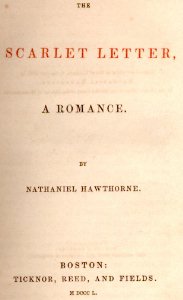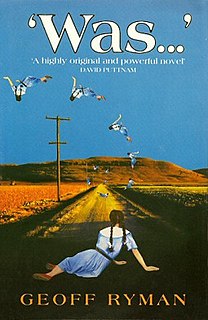Related Research Articles

Nathaniel Hawthorne was an American novelist, dark romantic, and short story writer. His works often focus on history, morality, and religion.

"The Black Cat" is a short story by American writer Edgar Allan Poe. It was first published in the August 19, 1843, edition of The Saturday Evening Post. In the story, an unnamed narrator has a strong affection for pets until he perversely turns to abusing them. His favorite, a pet black cat, scratches him one night and the narrator punishes it by cutting its eye out and then hanging it from a tree. The home burns down but one remaining wall shows a burned outline of a cat hanging from a noose. He soon finds another black cat, similar to the first except for a white mark on its chest, but he soon develops a hatred for it as well. He attempts to kill the cat with an axe but his wife stops him; instead, the narrator murders his wife. He conceals the body behind a brick wall in his basement. The police soon come and, after the narrator's tapping on the wall is met with a shrieking sound, they find not only the wife's corpse but also the black cat that had been accidentally walled in with the body and alerted them with its cry.

Henry James was an American-born British author. He is regarded as a key transitional figure between literary realism and literary modernism, and is considered by many to be among the greatest novelists in the English language. He was the son of Henry James Sr. and the brother of philosopher and psychologist William James and diarist Alice James.

A story within a story, also referred to as an embedded narrative, is a literary device in which a character within a story becomes the narrator of a second story. Multiple layers of stories within stories are sometimes called nested stories. A play may have a brief play within it, such as Shakespeare's play Hamlet; a film may show the characters watching a short film; or a novel may contain a short story within the novel. A story within a story can be used in all types of narration: novels, short stories, plays, television programs, films, poems, songs, video games, and philosophical essays.

"The Tell-Tale Heart" is a short story by American writer Edgar Allan Poe, first published in 1843. It is related by an unnamed narrator who endeavors to convince the reader of the narrator's sanity while simultaneously describing a murder the narrator committed. The victim was an old man with a filmy pale blue "vulture-eye", as the narrator calls it. The narrator emphasizes the careful calculation of the murder, attempting the perfect crime, complete with dismembering the body in the bathtub and hiding it under the floorboards. Ultimately, the narrator's actions result in hearing a thumping sound, which the narrator interprets as the dead man's beating heart.

The Scarlet Letter: A Romance is a work of historical fiction by American author Nathaniel Hawthorne, published in 1850. Set in Puritan Massachusetts Bay Colony during the years 1642 to 1649, the novel tells the story of Hester Prynne, who conceives a daughter through an affair and then struggles to create a new life of repentance and dignity. Containing a number of religious and historic allusions, the book explores themes of legalism, sin, and guilt.
Narration is the use of a written or spoken commentary to convey a story to an audience. Narration is conveyed by a narrator: a specific person or unspecified literary voice, developed by the creator of the story, to deliver information to the audience, particularly about the plot. Narration is a required element of all written stories, with the function of conveying the story in its entirety. However, narration is merely optional in most other storytelling formats, such as films, plays, television shows, and video games, in which the story can be conveyed through other means, like dialogue between characters or visual action.
A frame story is a literary technique that serves as a companion piece to a story within a story, where an introductory or main narrative sets the stage either for a more emphasized second narrative or for a set of shorter stories. The frame story leads readers from a first story into one or more other stories within it. The frame story may also be used to inform readers about aspects of the secondary narrative(s) that may otherwise be hard to understand. This should not be confused with narrative structure.

The Aspern Papers is a novella by American writer Henry James, originally published in The Atlantic Monthly in 1888, with its first book publication later in the same year. One of James's best-known and most acclaimed longer tales, The Aspern Papers is based on the letters Percy Bysshe Shelley wrote to Mary Shelley's stepsister, Claire Clairmont, who saved them until she died. Set in Venice, The Aspern Papers demonstrates James's ability to generate suspense while never neglecting the development of his characters.

The Tragic Muse is a novel by Henry James, first published as a serial in The Atlantic Monthly in 1889-1890 and then as a book in 1890. This wide, cheerful panorama of English life follows the fortunes of two would-be artists: Nick Dormer, who throws over a political career in his efforts to become a painter, and Miriam Rooth, an actress striving for artistic and commercial success. A cast of supporting characters help and hinder their pursuits.
A Passionate Pilgrim is a novella by Henry James, first published in The Atlantic Monthly in 1871. The story was the earliest fiction that James included in the New York Edition (1907–09) of his works. Set in England, the tale shows James' strong interest in the contrast between the Old World and the New. In fact, the difference between America and Europe erupts into open conflict in the story, which leads to an ironic ending.
Madame de Mauves is a novella by Henry James, originally published in The Galaxy magazine in 1874. The story centers on the troubled marriage of a scrupulous American wife and a far from scrupulous French husband, and is told mostly from the point of view of a male friend of the wife. The tale reflects the intense interest James took in the "international theme," especially early in his career. One of the longest fictions he had yet attempted, the smoothly narrated story shows that James was rapidly maturing in style and technique.

"The Real Thing" is a short story by Henry James, first syndicated by S. S. McClure in multiple American newspapers and then published in the British publication Black and White in April 1892 and the following year as the title story in the collection, The Real Thing and Other Stories published by Macmillan. This story, often read as a parable, plays with the reality-illusion dichotomy that fascinated James, especially in the later stages of his career. For the illustrator who narrates the story, the genuine article proves all too useless for his commercial purposes. The story portrays the unfortunate victims of a society in which reality and representation are closely intertwined in ways that make art a difficult project to disentangle the two.

"The Altar of the Dead" is a short story by Henry James, first published in his collection Terminations in 1895. A fable of literally life and death significance, the story explores how the protagonist tries to keep the remembrance of his dead friends, to save them from being forgotten entirely in the rush of everyday events. He meets a woman who shares his ideals, only to find that the past places what seems to be an impassable barrier between them. Although James was not religious in any conventional sense, the story shows a deep spirituality in its treatment of mortality and the transcendent power of unselfish love.
Mrs. Medwin is a short story by Henry James, first published in Punch in 1900. The story slyly satirizes fashionable society in fin-de-siècle England. The central characters are an American brother and sister who both entertain and live off this society, which has grown bland and bored and almost exhausted.

Was is a WFA nominated 1992 novel by Canadian author Geoff Ryman, focusing on themes of L. Frank Baum's 1900 novel The Wonderful Wizard of Oz, and the 1939 musical film version, ranging across time and space from 1860s Kansas to late 1980s California.

The New York Edition of Henry James' fiction was a 24-volume collection of the Anglo-American writer's novels, novellas and short stories, originally published in the U.S. and the UK between 1907 and 1909, with a photogravure frontispiece for each volume by Alvin Langdon Coburn. Two more volumes containing James' unfinished novels, The Ivory Tower and The Sense of the Past, were issued in 1917 in a format consistent with the original set. The entire collection was republished during the 1960s by Charles Scribner's Sons. The official title of the set was The Novels and Tales of Henry James, though the more informal title was suggested by James himself and appears as a subtitle on the series title page in each volume. It has been used almost exclusively by subsequent commentators.

The Death of the Lion is an 1894 short story by Henry James.
Charles Marlow is a fictional English seaman and recurring character in the work of novelist Joseph Conrad.

Mudbound (2008) is the debut novel by American author Hillary Jordan. It has been translated into French, Italian, Serbian, Norwegian, Swedish, and Turkish and has sold more than 250,000 copies worldwide. The novel took Jordan seven years to write. She started it while studying for an MFA in Creative Writing from Columbia University. It was adapted as a 2017 film of the same title.
References
| Wikisource has original text related to this article: |
- The Tales of Henry James by Edward Wagenknecht (New York: Frederick Ungar Publishing Co. 1984) ISBN 0-8044-2957-X
- A Henry James Encyclopedia by Robert L. Gale (New York: Greenwood Press 1989) ISBN 0-313-25846-5
- Meaning in Henry James by Millicent Bell (Cambridge, MA: Harvard University Press 1991) ISBN 0-674-55763-8
- A Companion to Henry James Studies edited by Daniel Fogel (Westport, CT: Greenwood Press 1993) ISBN 0-313-25792-2
- The Complete Notebooks of Henry James edited by Leon Edel and Lyall Powers (2005) ISBN 0-19-503782-0